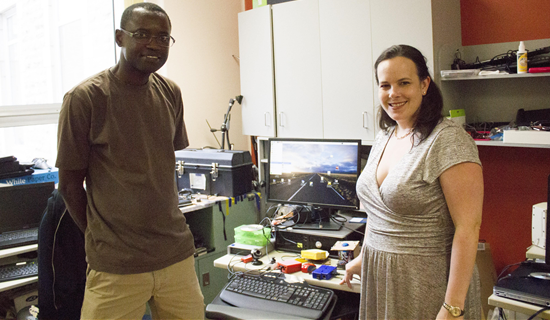
Bocar Ndiaye and Ellen Andrews are developing assistive technologies for the patients at St. Vincent Hospital
Bruyère developers are working on a universal operating system for accessibility
09/13/2018
Communication technologies, such as smartphones and web-based applications, are a critical component of modern life. However as these tools develop at an accelerating pace, how do we make sure they remain accessible for all? Applications such as Facebook and Gmail are always growing in complexity, adding an increasingly diverse array of features to their services. Bocar Ndiaye and Ellen Andrews fear that people who are disabled might get left behind.
“There are people who, due to one reason or another, need help interacting with today’s communication tools,” explains Bocar Ndiaye, an Assistive Technologist at the Bruyère’s Saint Vincent Hospital. People who are suffering from nerve damage, mild cognitive impairment, or who have experienced a stroke, may find interacting with a computer difficult and taxing. “In a society so centred on technology, it’s important to help people with disabilities access their email, Facebook, or other tools so that they can feel connected to their loved ones,” adds Bocar.
There are two key barriers in helping people access mainstream communication tools. The first is a matter of physical access. Many patients are unable to interact with computers, smartphones, or tablets due to some sort of physical disability. The task then is to create tools to allow easier interactions with a given device. To this end, Bocar Ndiaye, Ellen Andrews, and their team of volunteers and rehabilitation specialists are creating custom-made augmented and alternative communication tools for patients at St. Vincent Hospital, or AACs for short. These are specially designed pieces of tech that range in form and function, but are ultimately designed to help patients communicate with the world around them. They are built-to-order to meet the unique accessibility needs of each patient.
One example of an AAC is a touch-sensitive button that allows the user to select items on a screen or browse the internet. The button is touch-sensitive to prevent the patient having to push a physical button, which can cause pain in the hand. With the help of this tool, the person can now interact with a computer without needing to strain over a mouse and keyboard.
The next challenge in making software more accessible is the software itself. “Tools such as Gmail or Yahoo! Mail have hundreds of small icons, making it difficult for people with disabilities to interact with them,” explains Bocar.
This is where AATOS can make a difference. AATOS stands for Augmented Assistive Technology Operating System. The goal behind this system is simple: to help people with a disability interact with today’s mainstream software and online applications. The system is still in early development, but it will be made to interface with the various AAC tools developed by Bocar and his team. Through this software, patients will be able to use their AAC device to interact with communication software in a way that’s more accessible to them.
The operating system will also be open source. This means that developers around the world will be free to use the software and make their own adjustments as needed. This will help maintain flexibility in the software’s applicability to help patients.
The hope is that AATOS will help patients feel more independent and more connected to their loved ones.